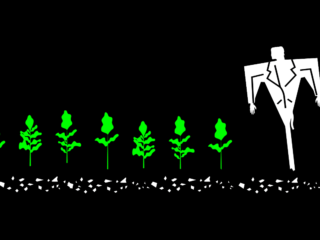How to Grow wheat in small spaces, and say “so long” to greggs

Wheat (Triticum aestivum, which rather delightfully translates as “bash it in the summer”) is basically just grass: grass that has been bred and cross-bred by humans over millennia to have ever fatter and more protein-rich seed-heads. And as as anyone who has done any weeding ever will tell you, grass grows like a bastard pretty much anywhere.
Wheat is also one of those food crops that, as soon as you start learning about nutrition-per-metre, you want to have a go at. Top of the zombie-garden calorie chart is potatoes, which in good conditions will yield up to 5,775 kCals per metre of planting[1]; whereas wheat can only manage 2,200-odd[2] But wheat flour is much easier to store, and stays edible way longer than spuds, which sooner or later start sprouting and turning green. Sow wheat seed close enough together and you don’t need to weed much; plus there’s none of the digging required with potatoes, or the long-winded, fiddly rigging of frames for runner beans. That combination of low input of time, high output of calories makes wheat a strong contender for a place in a zombie garden.
No surprise then, that we’ve been experimenting with it. We’ve sown patches of it in our raised beds in the old sand school, in open ground in the forest garden, and in containers. So far we’ve had more success with the containers. Small areas in open ground quickly get eaten down by rabbits at the seedling stage – though this shouldn’t be a problem for those of you growing in towns and cities. Meanwhile our raised beds are sitting on an artificial, rubber-and-sand surface; and with a soil depth of only 50cm deep they’re a bit shallow. In ideal conditions, wheat’s roots are meant to be able to penetrate as deep as two metres, though at least one study suggests that modern wheat varieties can grow useful (ie water-sucking) roots no deeper than 60cm. If you’ve got raised beds on soil – in an allotment or a back garden for instance – wheat would probably be perfectly happy.
For us, though, containers have been foolproof – as long as they are deep enough, and properly watered and fed, wheat seems to romp away. Because they’re light, deep, and we had some to hand, we use old plastic dustbins, two-thirds filled with a mix of home-made compost and top soil, and with plenty of holes drilled in the bottom for drainage.
So far we’ve stuck to winter wheat, which you sow in September/October, a time when other jobs in the zombie garden are winding down. It’s ready to harvest about nine months later, in high summer, by which time our dustbins will all be bearing shocks of tawny stalks as if they’d had the same en brosse haircut.
None of the gardening books we had gave any advice about how to sow and grow wheat, so instead we followed a scaled-down version of the growing advice given to farmers by governments in temperate climates – most useful was the free Winter Wheat Guide published by the Irish Agriculture and Food Development Authority in 2016. Step-by-step, here’s how we go about it.
Sourcing seed
Probably the only tricky thing about growing small-scale wheat is finding the seed. Wheatgrass seed is sold widely online by healthfood specialists, and is, yes, wheat – but not a variety that makes the kind of “hard”, high-protein flour you need for good bread. We save our own seed now, but for our first year’s sowing we bought from Franchi Seeds of Italy: it has a bread-making variety of hard winter wheat in 100g packs, which is enough to sow about 10 square metres and provides enough flour for up to 20 medium sized loaves. If you want to sow a larger area, ask an agricultural seed supplier to sell you what’s known as a trial pack – these come in 1kg or 5kg bags. Avoid buying a hybrid variety, though, as then you won’t be able to save your own seed for next year.
Sowing
Sometime early in September, we get our bins in position somewhere open and sunny, but sheltered from the worst of the winter winds. Then we two-thirds fill them with a 50/50 mix of topsoil and home-made compost, tested with a soil probe to check the pH is no lower than 6.5, the optimum for wheat. (Our soil is nearly always neutral, but if by any mad chance it had dropped below 6.5 we’d add a little bit of woodash to raise the alkalinity). We give this a water, and wait for all the inevitable weed seeds to germinate. After a couple of weeks, they’ll have sprouted like mustard and cress and we can quickly hoe them off while shouting “Die, weeds, die!”
Once this is done, in late September or early October we scatter 4g of wheat (roughly 80 seeds) across the surface the soil in each dustbin – equivalent to a sowing rate of 325 seeds per square metre[3] – and sieve over another 5cm of compost/soil, before watering with a fine rose or a hose-spray on a mist setting: as always with seeds, you want the soil around them air-filled and just wrung-sponge moist, not battered down and sopping wet.
Then we cover the bins with some fleece or insect net, fastened round the rim with bungee cords, to stop birds and squirrels eating the seed. The fleece stays on until seedling shoots emerge, usually from five to 14 days later. Slugs are potential problem at this point, so we regularly check under the bins for any lurkers until shoots are 10cm high or so high. After that, it’s feet up til February.
Feeding and watering
We don’t water at all until the early spring, or we’d risk waterlogging the containers and rotting the roots of the young plants – plus there’s very little growth going on until early February, when the fresh green shoots suddenly start shooting up. That’s the moment to do as arable farmers do: feed with a nitrogen-rich fertilizer. We use pelleted chicken manure, but urine diluted 1-10 with tap water has the same effect. And yes we did say urine. We’ll post about that later. Betcha can’t wait!
We follow with a second nitrogen feed in late March, and start to keep an eye on watering; if ever the soil/compost is dry more than a couple of inches below the surface the bins get a good soak.
Finally in May we give a dose of a potassium-rich feed – comfrey tea if we’ve got it, liquid tomato fertilizer if we haven’t – to help the ears, or seed heads, form. After that, feeding stops, otherwise the wheat might grow too high and “lodge” – aka fall over on itself. Once the stalks and ears of the wheat are beginning to fade from green to brown we stop worrying about watering.
Harvest and dry
You harvest winter wheat sometime between June and August, once the grains of wheat have ripened to the point where they don’t dent when you press a fingernail into them. As this is a small-scale operation, we can just cut the stalks close to the soil surface with a pair of shears – chucking any with ears that look shrivelled, blackened or mouldy – then tie them in bunches and hang them upside down somewhere cool and airy to dry: the old stables would be perfect, except that the resident housemartins would poo all over them. And our polytunnels are too hot at that time of year, so more often than not our wheat stalks end up hanging from the airer in the utility room.
Then follows the horror that is threshing and winnowing (subjects we’ll deal with in a later post) to free the wheat grains from the stalks. Once the seed is free, we hold some back for sowing next year, then – not having quite got round to building an on-site windmill – grind the rest to flour in a food processor.
That’s it – of all the crops we grow, wheat is one of the least troublesome. If we were scaling up, pests and fungal diseases such as rust would probably kick in, but when it’s confined to a small area and surrounded by other crops it’s virtually problem-free. If you fancy having a go, we’d definitely recommend it.

Hybrid A hybrid is a) a car mostly owned by people who want to save the planet while also still driving to work, and b) the result of cross-pollination between two different varieties of the same plant. Hybrid varieties of veg are often great, but their seed won’t grow into plants with the same characteristics. This means there’s no point saving it and you’ll have to buy fresh seed each year.

[1] Based on RHS Trials Report: Maincrop Potato 1993, and USDA Food Composition Databases
[2] Based on 80 per cent of average yields 2013–2017, Agriculture in the United Kingdom 2017 and USDA Food Composition Databases
[3] Sowing rate provided by Elsoms Seeds Ltd








